Tribal elders say the Taliban are far from defeated. The Taliban continue to wage a brutal war, taking a toll on Afghan citizens and American forces. The Department of Defense has identified 1,761 American service members who have died in the Afghan war and related operations as of Sept. 21, about 10 years since the start of the war. In visiting Afghanistan monthly in The Big Picture, we try to reflect our troops presence in the country as well as their interaction with the Afghan people. -- Paula Nelson (54 photos total)

US soldiers from the 27th Infantry Regiment fire 120-mm mortar rounds toward insurgent positions at Outpost Monti in Kunar province on Sept. 17. After a decade of fighting in Afghanistan, 130,000 troops from dozens of countries continue to battle resilient Taliban, who use homemade bombs and guerrilla tactics in a bid to undermine the Afghan government and the NATO mission. (Tauseef Mustafa/AFP/Getty Images)

The United States, which had largely pulled out of Kunar province, has recently moved troops, including the 27th Infantry Regiment, back in as part of an effort to take the battle to Taliban strongholds. The mountainous region of Kunar borders Pakistan and is often a transit point for Taliban between the countries. (Tauseef Mustafa/AFP/Getty Images)

Specialist Gart Kamon, of the 27th Infantry Regiment, is peppered with stones after firing mortar rounds at Outpost Monti in Kunar province. (Tauseef Mustafa/AFP/Getty Images)

A muddied Gart Kamon, an Army specialist, is part of the coalition effort to help Afghan troops take control of restive Kunar province. (Tauseef Mustafa/AFP/Getty Images)
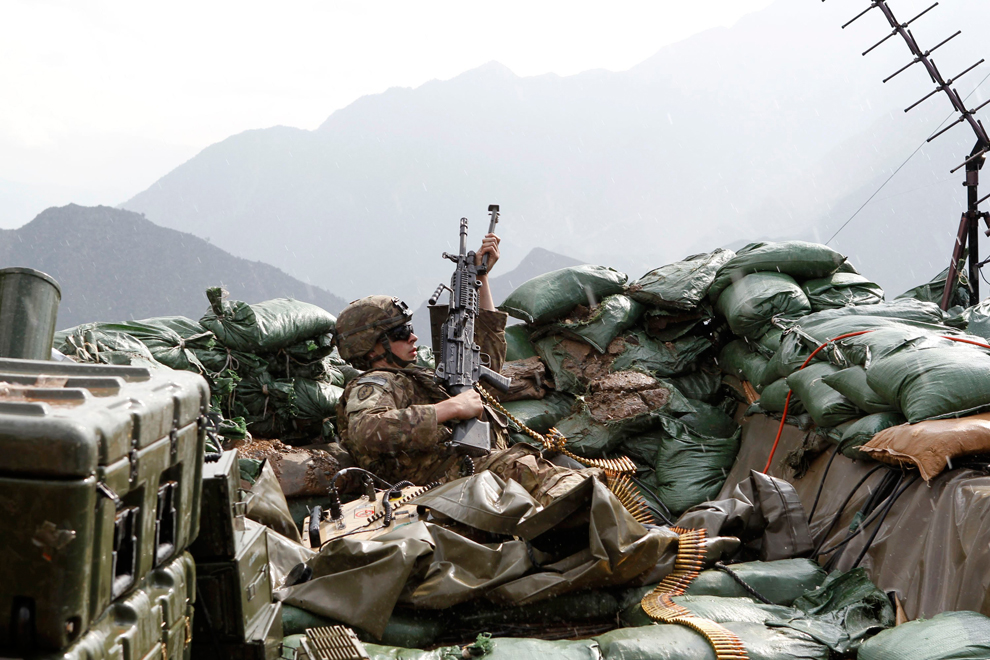
A US soldier from the 2-27 Infantry's "Wolfhounds" takes cover during a firefight with the Taliban at Outpost Bari Alai in Ghaziabad district in Kunar on Sept. 15. (Erik De Castro/Reuters)

Lieutenant Steve Grizley of the 2-27 Infantry "Wolfhounds" takes care of some grooming during a lull at Outpost Bari Alai in Ghaziabad district in Kunar. (Erik De Castro/Reuters)

A US soldier observes a bombing strike from a US fighter jet during a firefight at Outpost Bari Alai in Kunar on Sept. 15. (Erik De Castro/Reuters)

US soldiers fire 60mm mortar rounds toward a Taliban position during a firefight at Outpost Bari Alai, in Kunar. (Erik De Castro/Reuters)
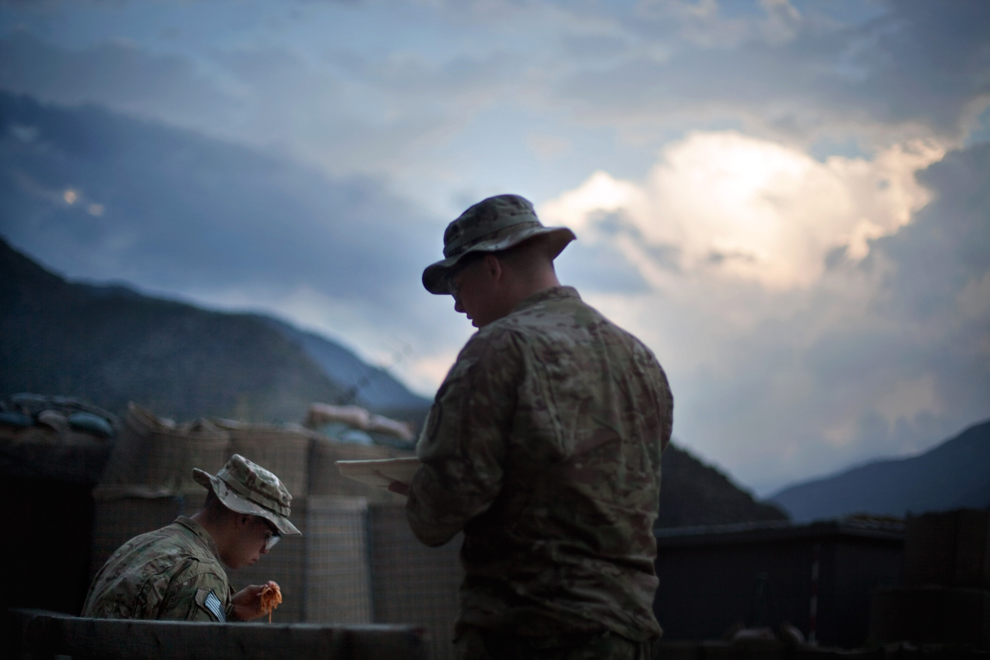
Private Jason Garcia, of Orange County, Calif., (left) and Specialist Nathan Deboard, 25, of Plano, Texas, eat a pasta dinner outside their barracks at Outpost Monti in Kunar province on Sept. 15. The soldiers are with the Second Battalion 27th Infantry Regiment, based in Hawaii. (David Goldman/Associated Press)

A US fighter jet drops bombs at Taliban positions during a firefight at Outpost Bari Alai. (Erik De Castro/Reuters)
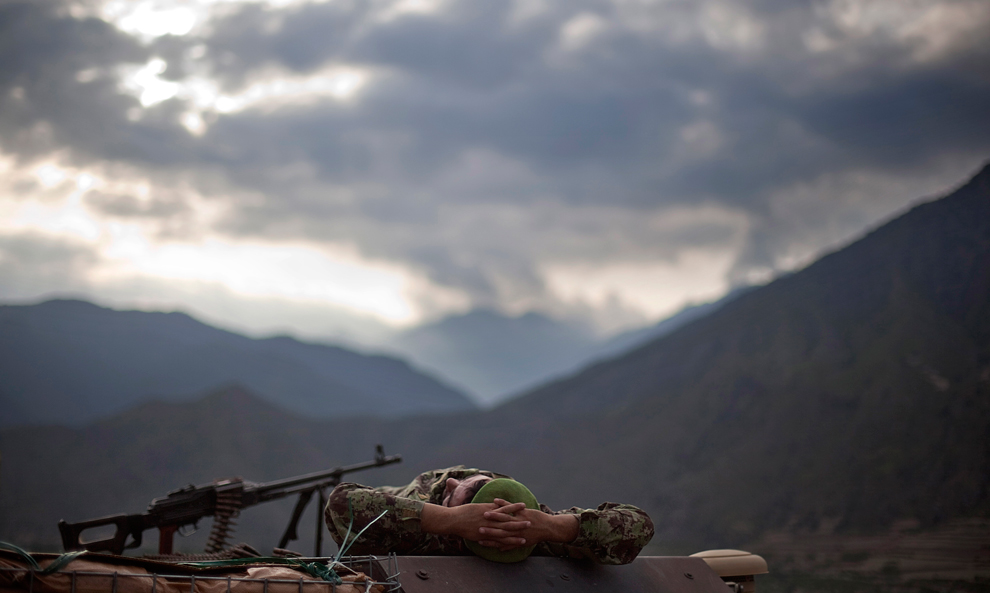
An Afghan soldier wakes up atop his armored vehicle following an overnight mission with soldiers of the US Army's 27th Infantry Regiment in Shigal, Kunar province. (David Goldman/Associated Press)

Staff Sergeant James Waldo, 28, of Columbia, S.C., awakes after sleeping under a trailer, which provided cover from the night's rain during a mission in Shigal, Kunar province. Waldo is with the 27th Infantry Regiment. (David Goldman/Associated Press
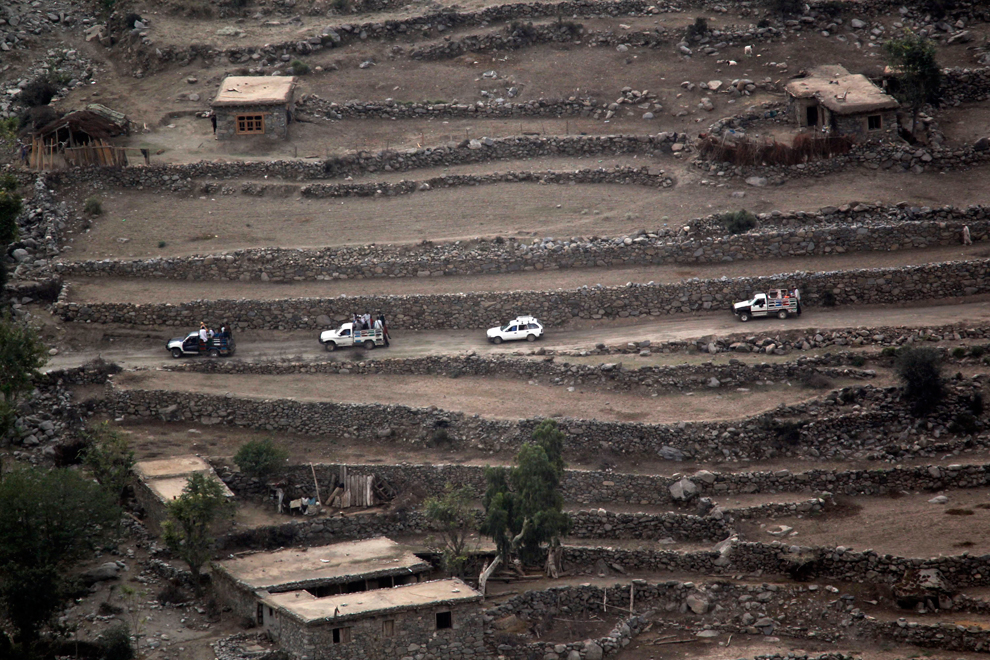
A convoy passed a village, as viewed from a bunker at Outpost Bari Alai in Kunar. (Erik De Castro/Reuters)
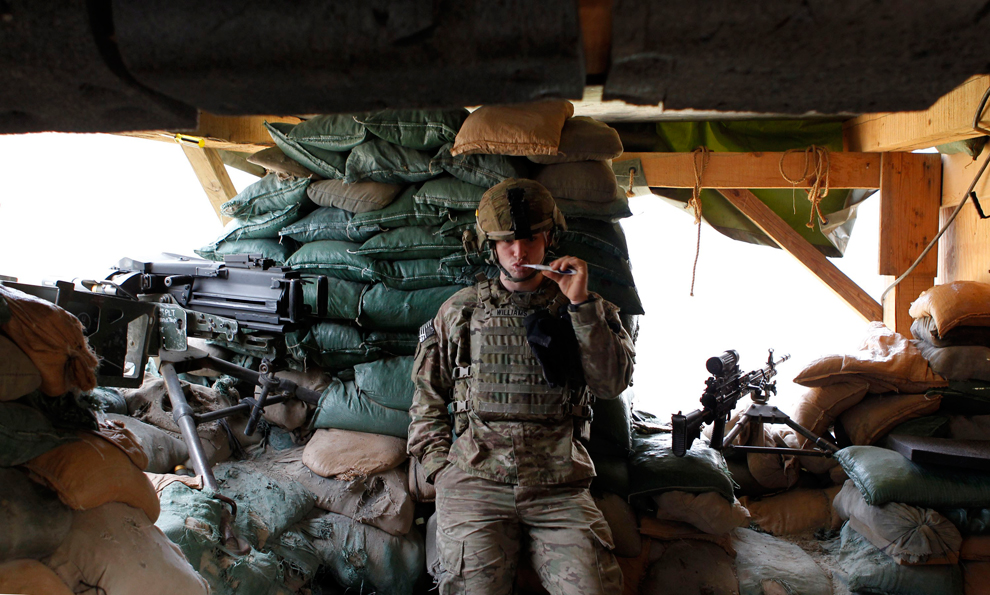
A soldier from Task Force "No Fear" of the 2-27 Infantry brushes his teeth between machine guns at his post in the bunker of Outpost Bari Alai in Kunar. (Erik De Castro/Reuters)
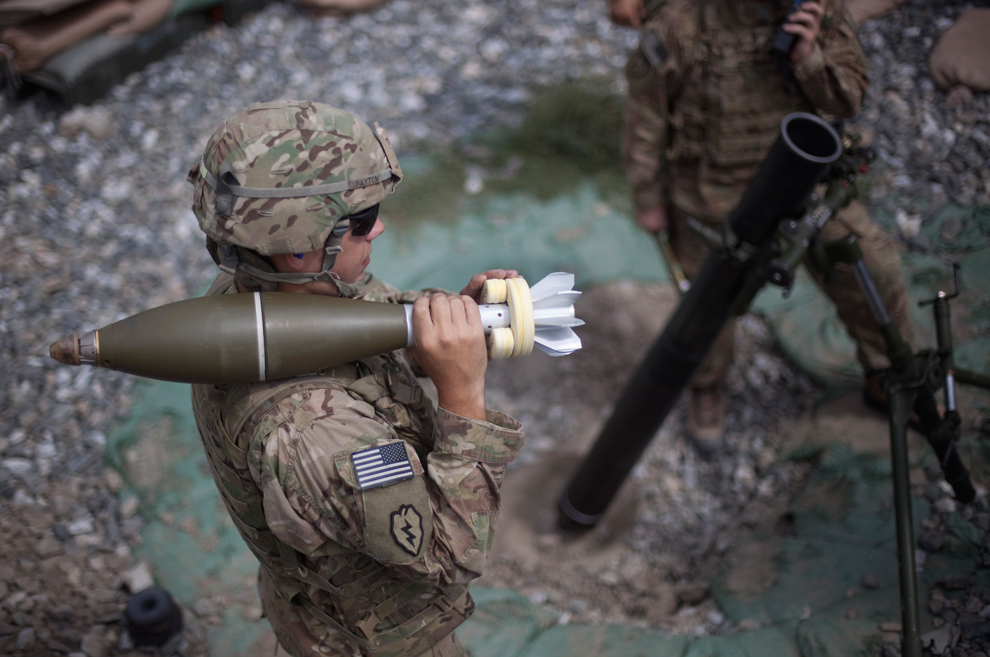
Private Chad Payton, 21, of Louisville, Ky., prepares to load a 120mm high-explosive mortar round in support of an Afghan outpost under attack by insurgents on Sept. 14 in Kunar province. (David Goldman/Associated Press)
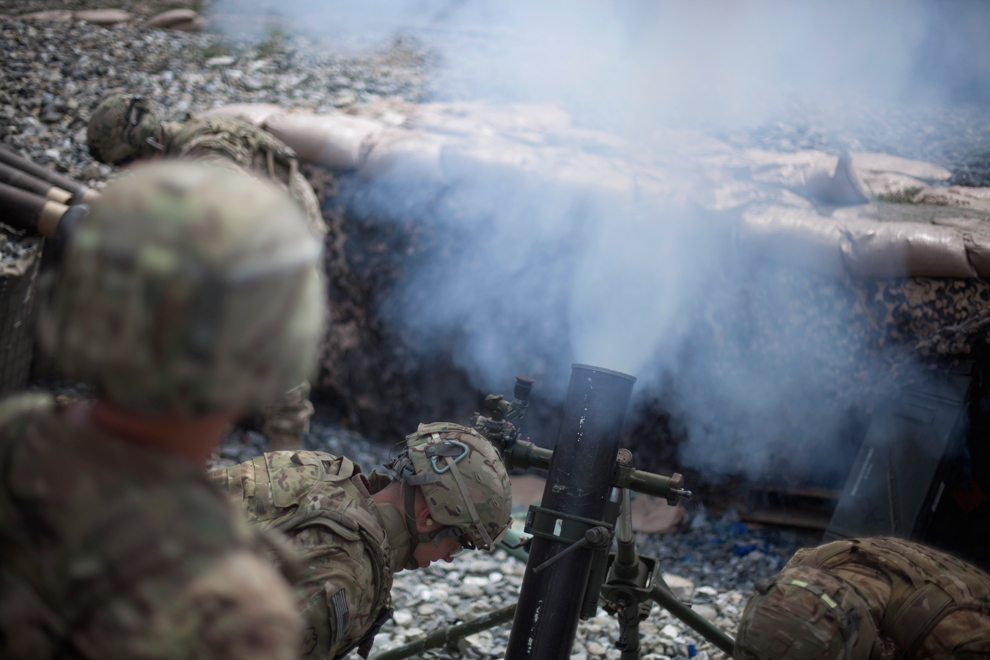
Soldiers with the 27th Infantry Regiment fire a 120mm mortar round from Combat Outpost Monti in Kunar province. (David Goldman/Associated Press)
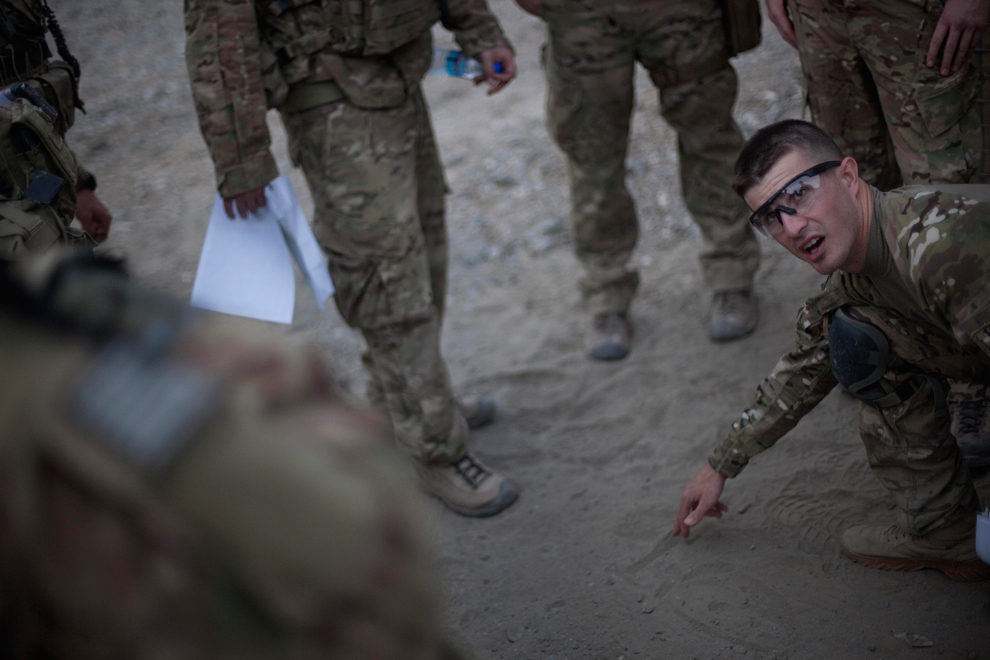
Second Lieutenant Andrew Ferrara, 23, of Torrance, Calif., draws a map in the sand during a briefing before a mission on Sept. 14 at Combat Outpost Monti in Kunar province. (David Goldman/Associated Press)

Second Lieutenant Andrew Ferrara, with the 27th Infantry Regiment, packs Gobstopper candy with the rest of his arsenal. (David Goldman/Associated Press)
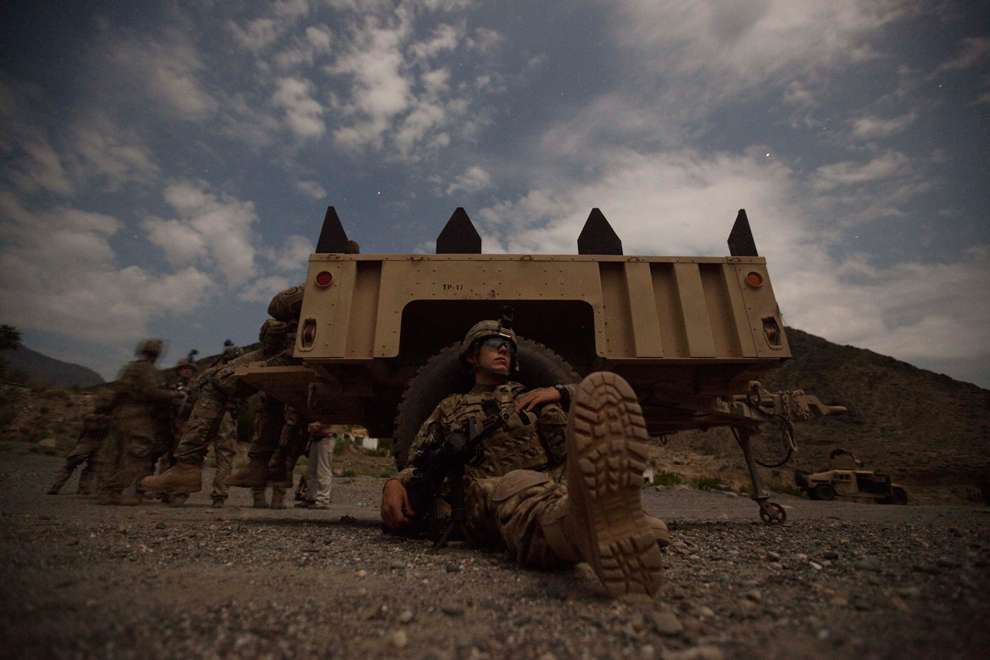
Illuminated only by moonlight in this long exposure photograph, Private Chad Payton, 21, of Louisville, Ky., rests against a trailer during a night mission early Sept. 15 at Combat Outpost Monti in Kunar province. (David Goldman/Associated Press)
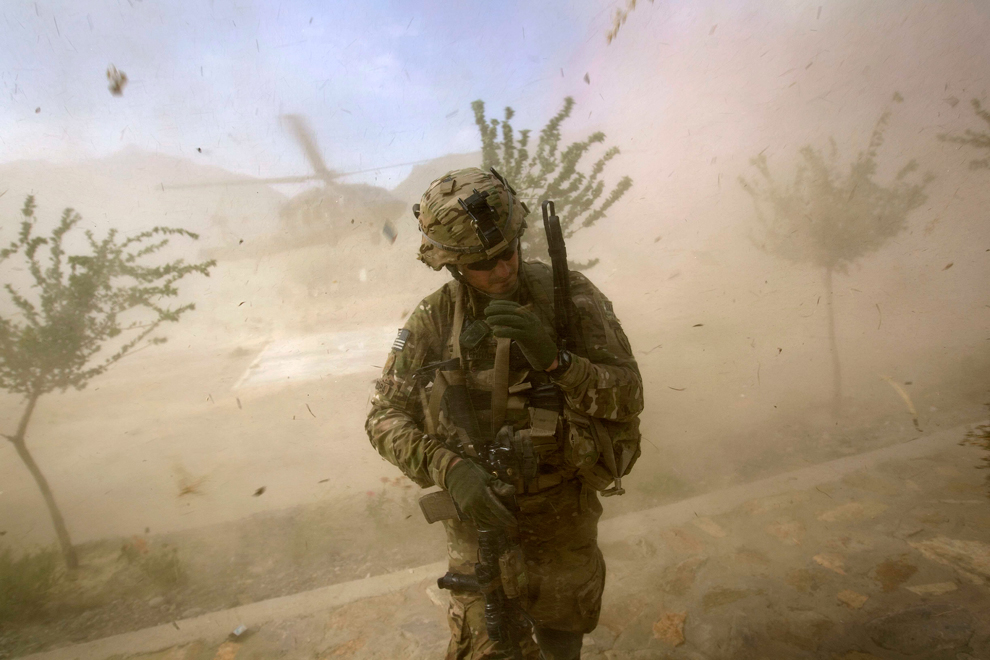
The rotors of a landing Blackhawk helicopter kick up dust and debris around Second Lieutenant Andrew Ferrara at the Shigal district center in Kunar province on Sept. 15. Ferrara is helping coordinate a meeting with village leaders. (David Goldman/Associated Press)

A truck carries villagers near Outpost Bari Alai in Kunar. (Erik De Castro/Reuters)

Villagers speak with Second Lieutenant Andrew Ferrara during a key leader engagement at the Shigal district center on Sept. 15 in Kunar province. (David Goldman/Associated Press)
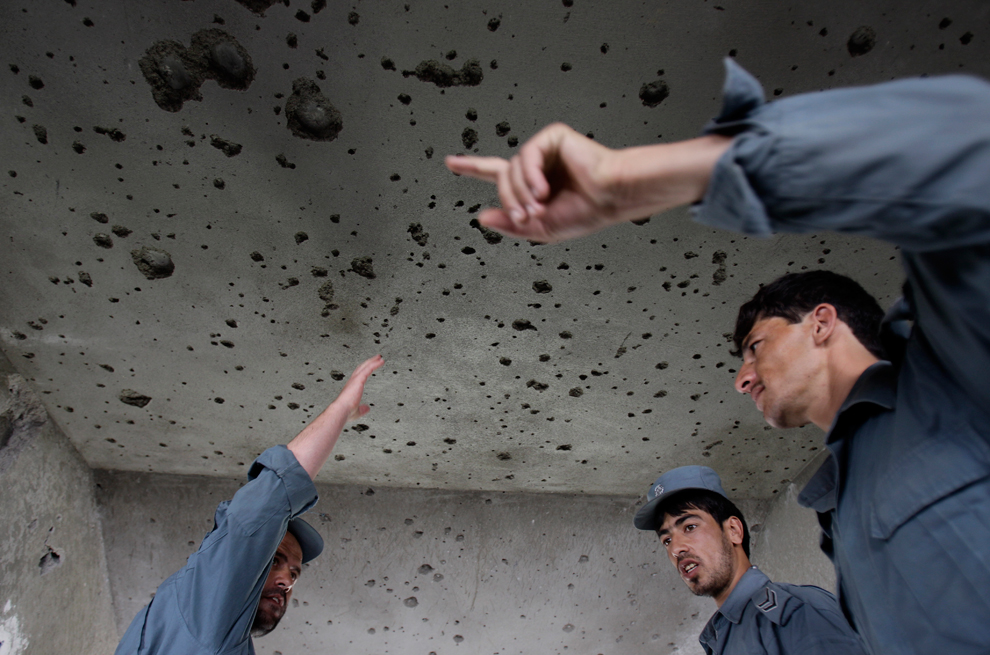
Afghan police visit a building that Taliban militants had taken over during a 20-hour raid in the heart of Kabul. The insurgents, armed with rocket-propelled grenades and suicide vests, attacked the US Embassy and NATO headquarters. The siege ended with a volley of helicopter gunfire as Afghan police ferreted out and killed the last few assailants, who had taken over a half-built 14-story building in order to fire on the embassy. In all, at least 16 people, including nine insurgents, were killed. (Kamran Jebreili/Associated Press)
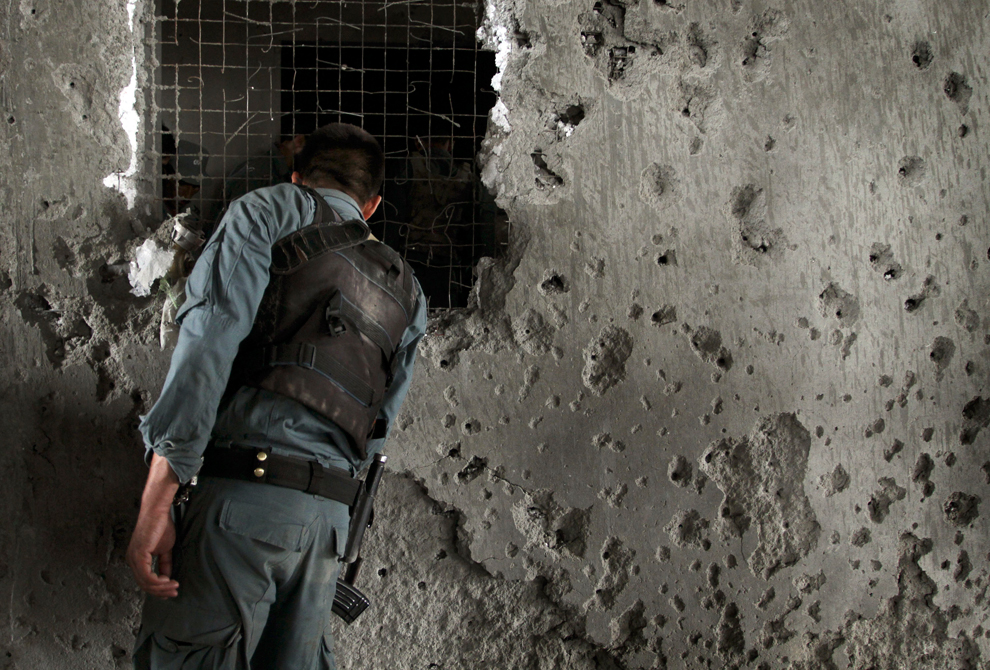
An Afghan policeman looks at the bodies of militants in a building they had occupied in their attack on the US Embassy in Kabul. (Musadeq Sadeq/Associated Press)
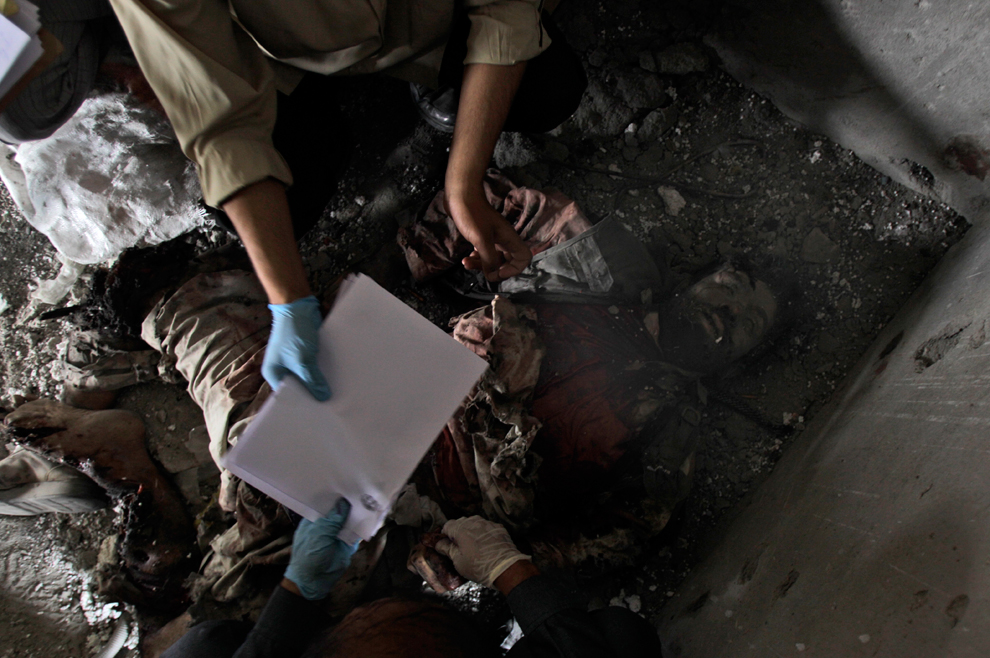
Afghan medics take fingerprints from one of the Taliban militants killed during a gun battle with Afghan and NATO forces in Kabul on Sept. 14. (Kamran Jebreili/Associated Press)
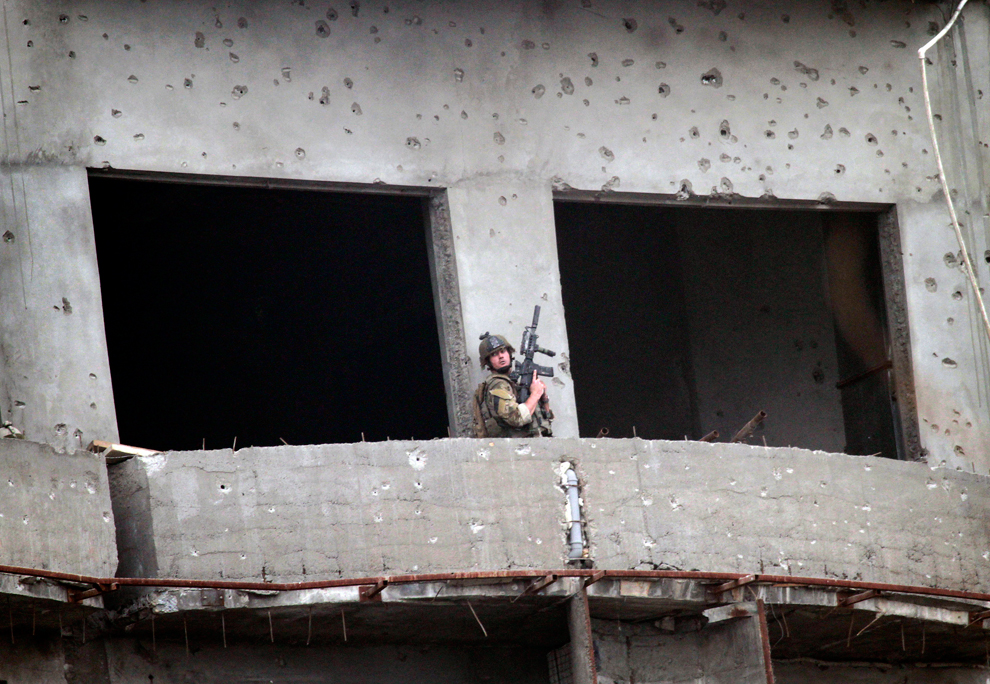
A soldier, part of the coalition forces, pauses during a gun battle with Taliban militants in a building in Kabul on Sept. 14. (Musadeq Sadeq/Associated Press)
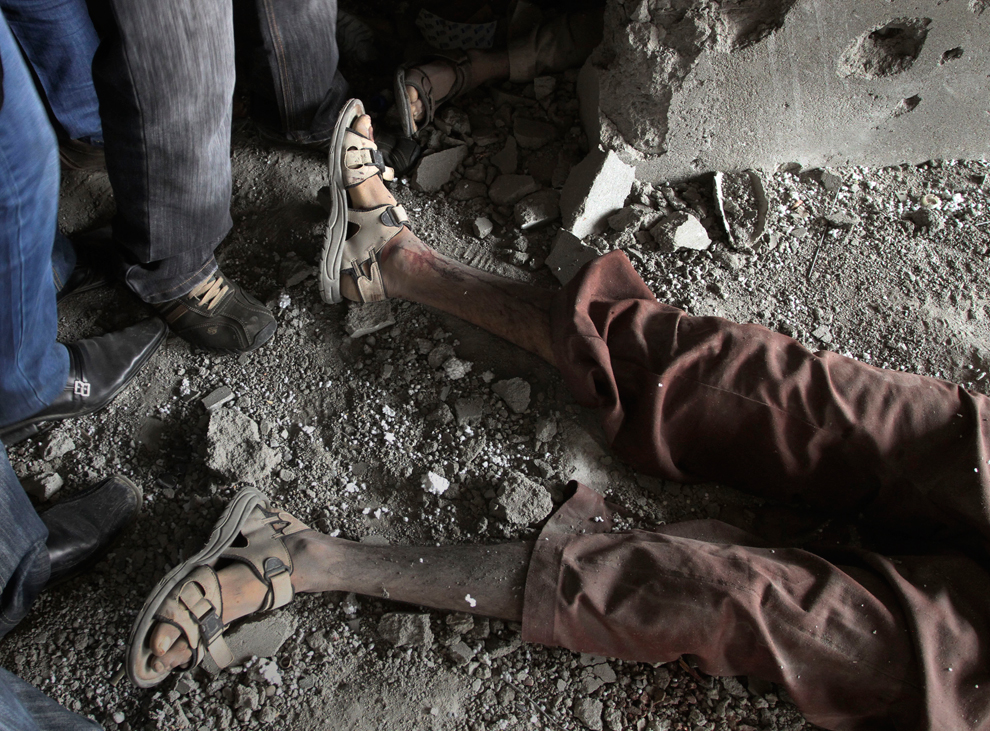
Afghan security men and media members gather around the body of a militant at a building in Kabul on Sept. 14. The brazen 20-hour attack demonstrated the ability of the Taliban to strike terror in the heart of the capital. (Musadeq Sadeq/Associated Press)

Afghan security forces cheer atop a building after all the militants, who had occupied the building, were killed in Kabul on Sept. 14. The brazen attack had to have been assisted by insiders in the military, some officials said, since the heavily-armed men were able to easily bypass a series of checkpoints to get to the center of the capital. “The nature and scale of today’s attack clearly proves that the terrorists received assistance and guidance from some security officials within the government who are their sympathizers,” said Mohammed Naim Hamidzai Lalai, chairman of Parliament’s Internal Security Committee. (Musadeq Sadeq/Associated Press)

Workers from the health ministry call their families during fighting between the militants and Afghan security forces in Kabul on Sept. 13. Taliban insurgents fired rocket-propelled grenades and assault rifles at the US Embassy, NATO headquarters, and other buildings in the heart of the Afghan capital. No US citizens were killed, although one grenade pierced the wall of the compound. (Musadeq Sadeq/Associated Press)
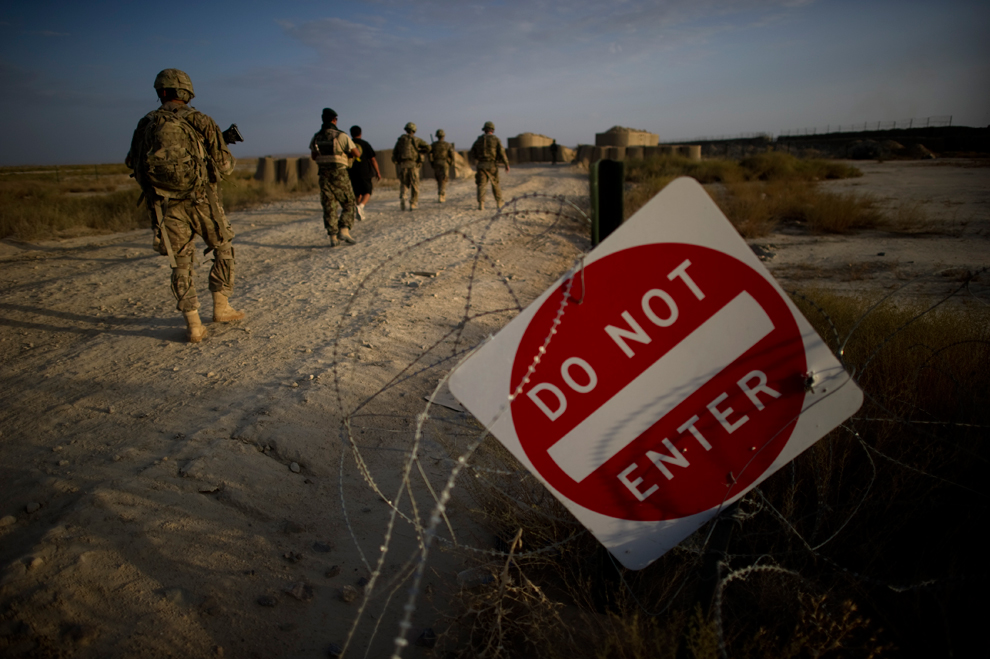
Soldiers of the 172nd Infantry Brigade approach the forward operating base Kuschamond on Sept. 12 in Paktika province. (Johannes Eisele/AFP/Getty Images)
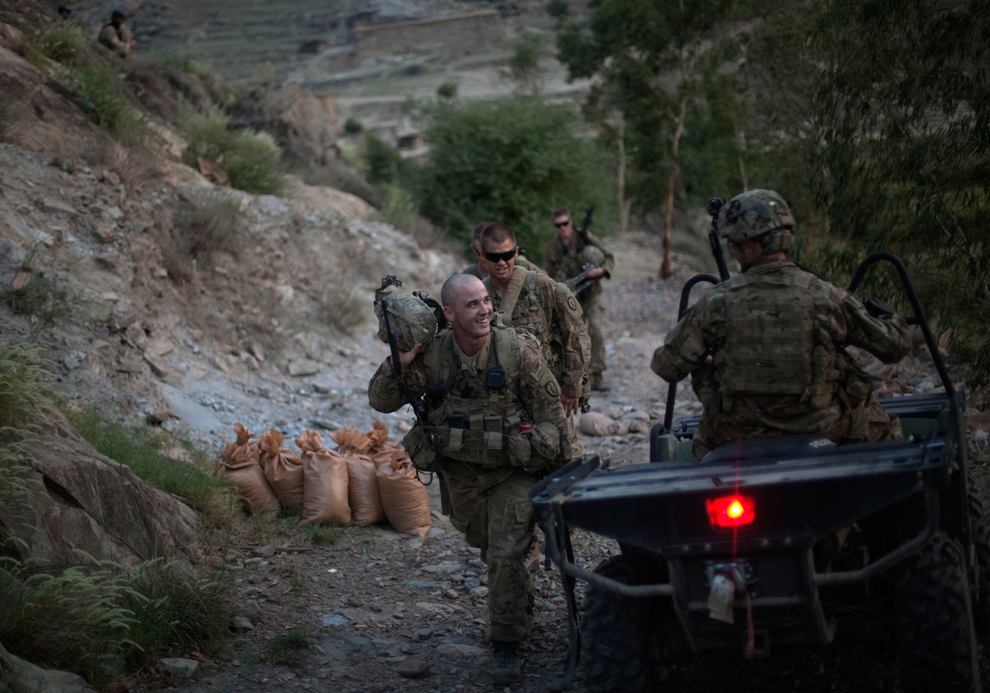
Sergeant Matt Murray, 25, of Warwick, R.I., greets Second Lieutenant Andrew Ferrara while hiking up to an observation post on Sept. 12 at Combat Outpost Monti in Kunar province. (David Goldman/Associated Press)
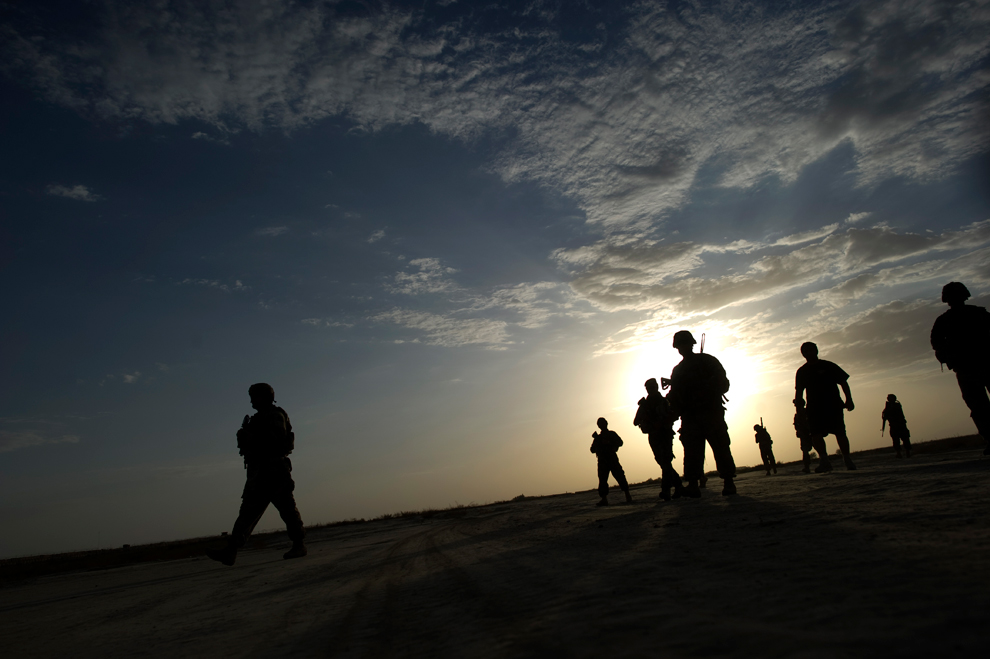
US soldiers walk toward the Kuschamond forward base in Paktika province. So far, the 10-year war has cost America $444 billion. There are currently approximately 130,000 NATO-led forces in Afghanistan; 100,000 of them from the United States. (Johannes Eisele/AFP/Getty Images)

Sergeant Daniel Chavez, an Army flight medic from Rio Rancho, N.M., hold his gun aloft as fellow medic Specialist David Bibb, from Santa Fe, waves an American flag as they commemorate the 10th anniversary of the 9/11 attacks at Forward Operating Base Edi in the Helmand province of southern Afghanistan on Sept 11. (Rafiq Maqbool/Associated Press)
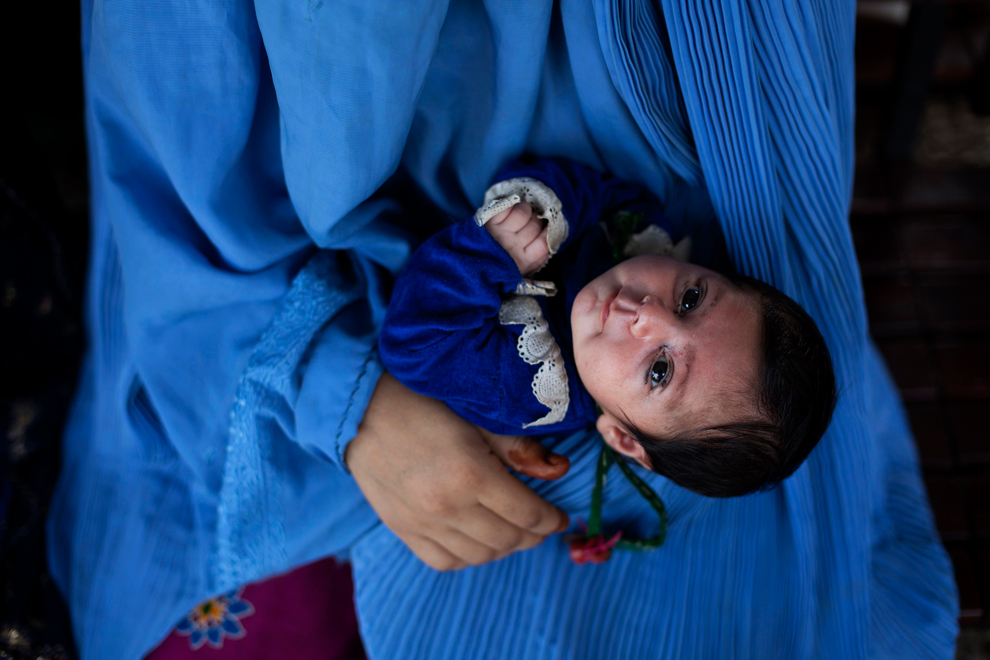
Zaneb Bibi holds her 11-day-old daughter, Rahmat, as they wait to go back to Afghanistan from a UN-funded repatriation center in the western city of Peshawar on Sept. 11. About 3.5 million Afghans have returned home since 2002 from Pakistan with the assistance of aid agencies, the United Nations said. (Adrees Latif/Reuters)
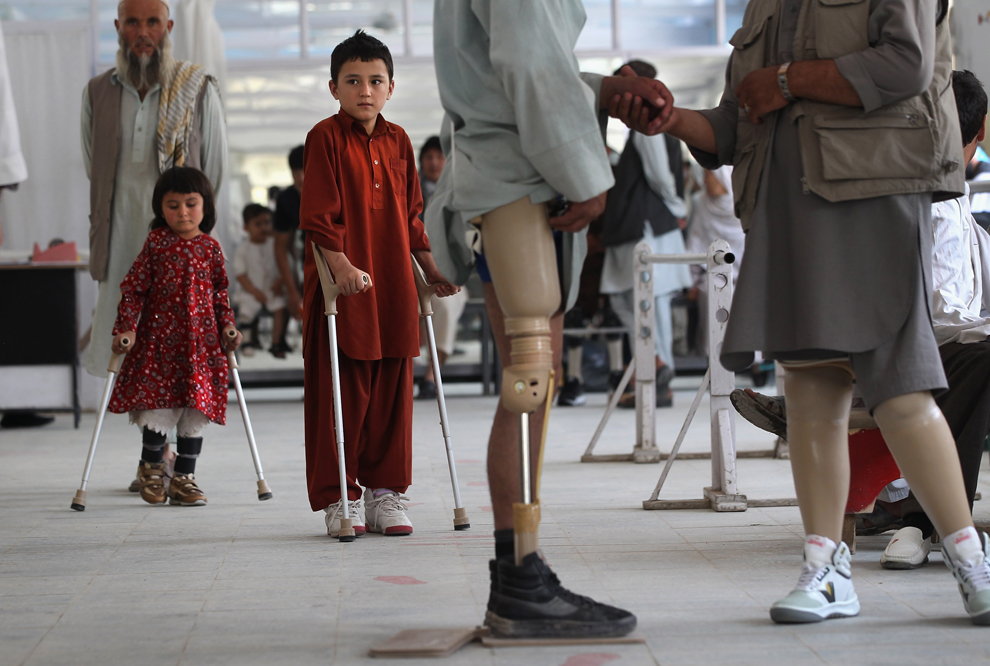
Afghan war amputees and children practice walking at the International Committee of the Red Cross orthopedic center on Sept. 10 in Kabul. After more than 30 years of war and a decade since the 9/11 attacks in the United States, thousands of Afghans, both military and civilian, continue to pay a heavy price from the conflicts. The center makes prosthetics for amputees and helps them, as well as Afghans with spinal injuries and children with congenital birth defects, to learn to walk. (John Moore/Getty Images)

An orthopedic technician adjusts a prosthetic leg for a war amputee at an International Committee of the Red Cross center in Kabul. (John Moore/Getty Images)

Afghan police pose for photos at a shrine for slain Afghan leader Ahmad Shah Massoud on Sept. 9 in Kabul.. Afghans observed the 10th anniversary of Massoud's assassination by Al Qaeda agents, only two days before the 9/11 attacks in the United States. The military leader played a leading role in driving the Soviet army out of Afghanistan, earning him the name Lion of Panjshir. He was a chief opponent of the Taliban after their rise to power in 1996. Millions of Afghans consider him the nation's greatest modern hero. (John Moore/Getty Images)
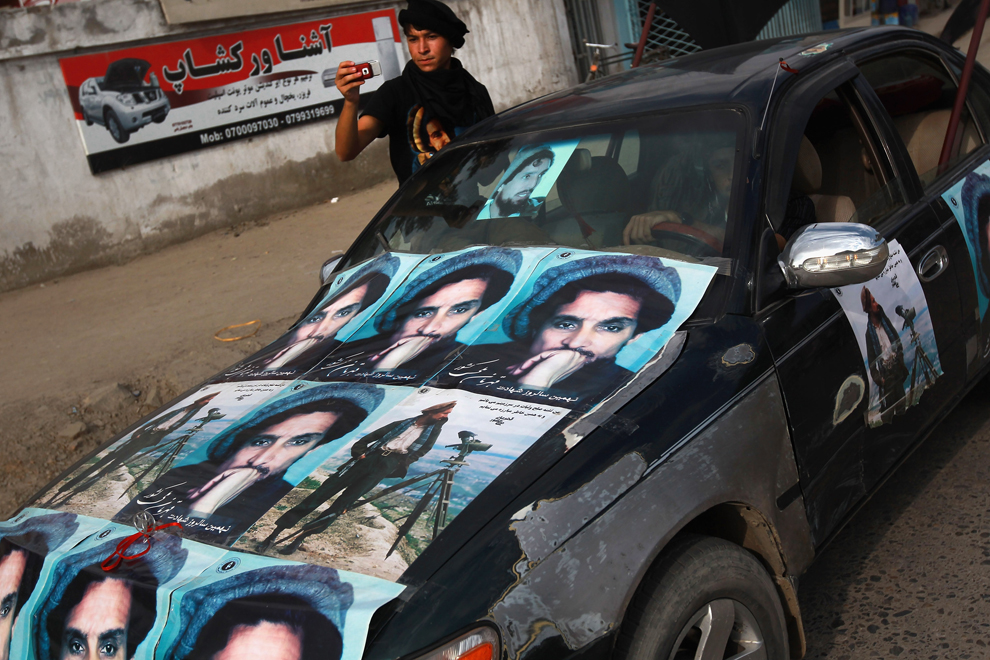
Afghans drive through Kabul in respect for slain Afghan leader Ahmad Shah Massoud on Sept. 9, the tenth anniversary of his assassination. (John Moore/Getty Images)
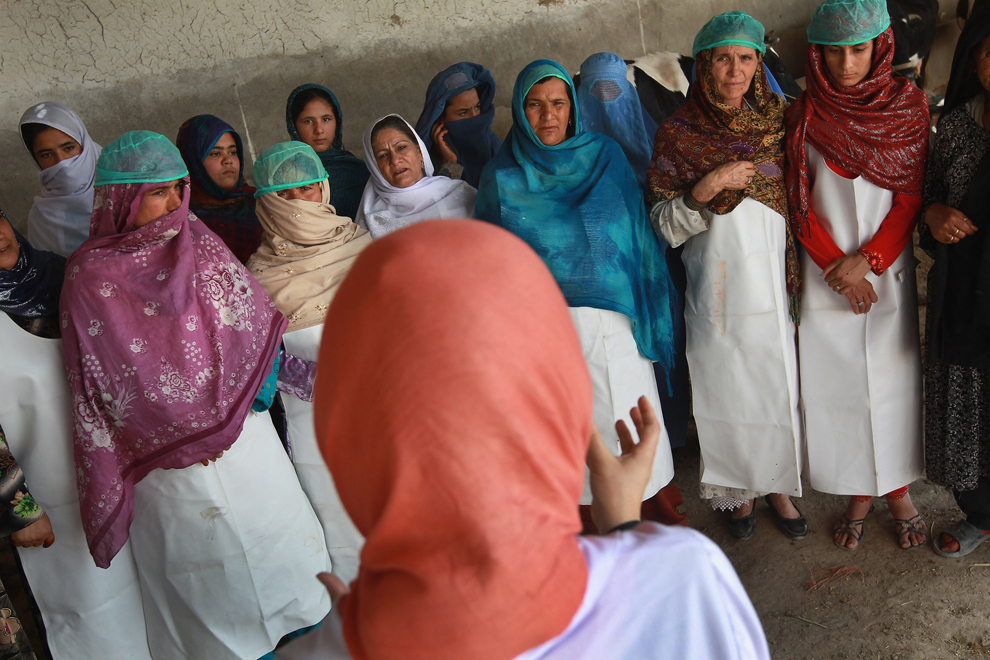
Afghan women listen to a trainer during an animal husbandry class on Sept. 8 in Kabul. The program, run by the Afghan Women Rights Organization, is aimed at educating women on ways to raise their household income. The program is funded by the US Ambassador's Small Grants Program and USAID. (John Moore/Getty Images)
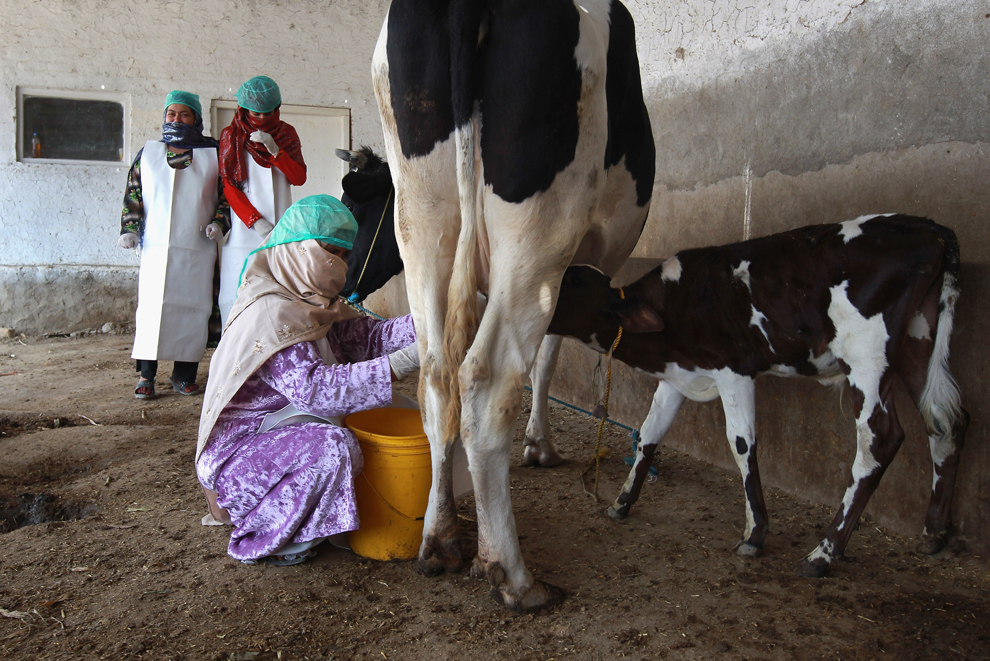
An Afghan woman milks a cow during an animal husbandry class, September 8, 2011 in Kabul. (John Moore/Getty Images)
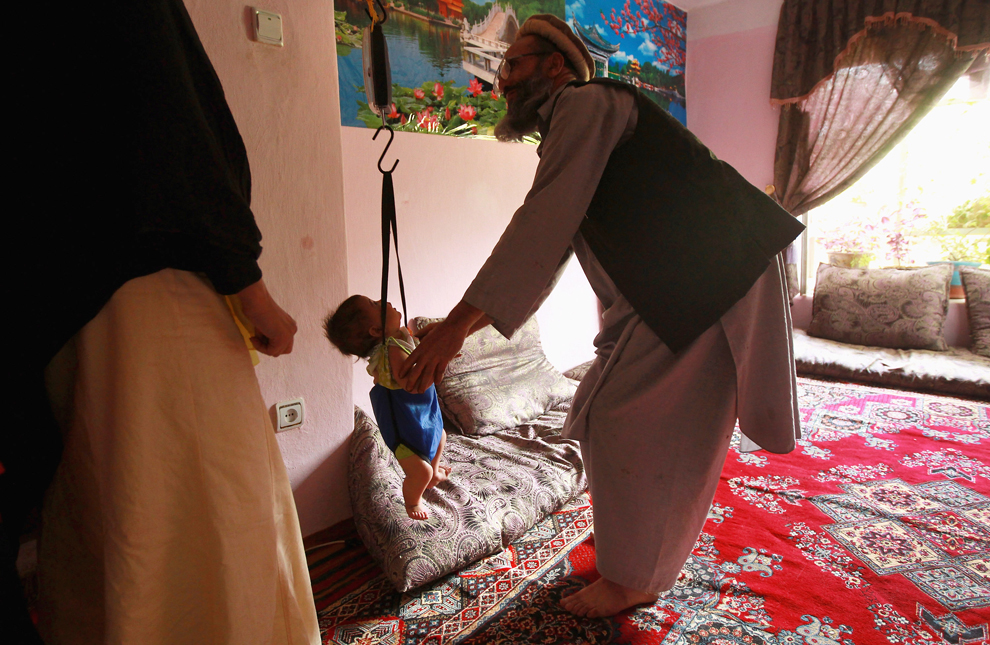
An Afghan vollunteer weighs a child at a USAID-funded health help center, September 7, 2011 in Farza, Afghanistan. More than $2 billion of American development money will be spent in Afghanistan in 2011. The goal is to provide basic health services for Afghans throughout the nation and to lower Afghanistan's child and maternal mortality rate, among the highest in the world. (John Moore/Getty Images)
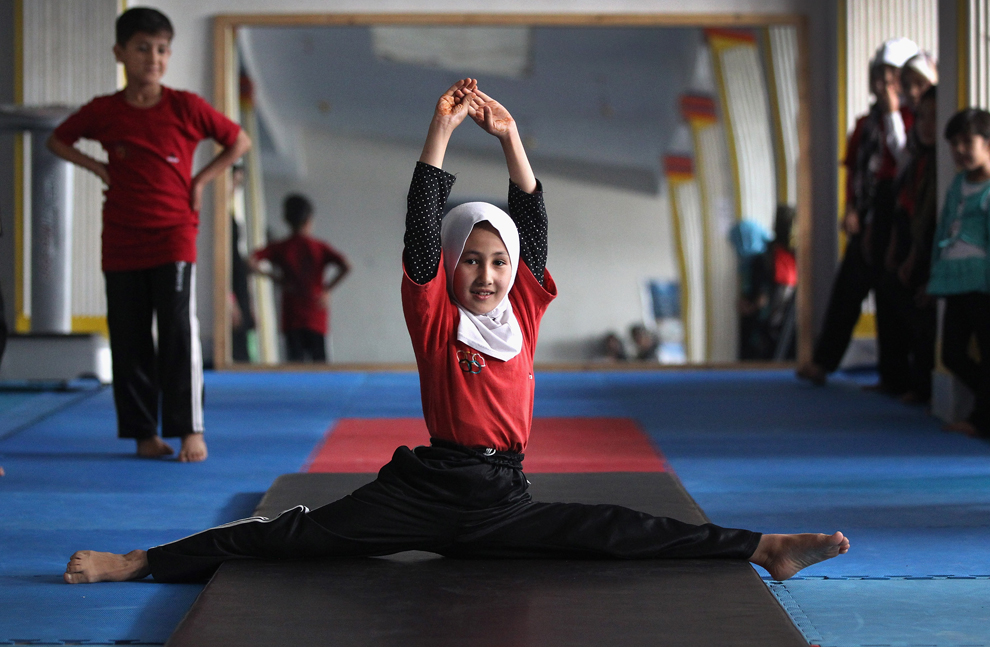
An Afghan girl practices during gymnastics class at a U.S. funded gymnasium for women women, September 7, 2011 in Kabul. The facility, called the Alzahra Cultural and Sport Association, is the only gym for women in western Kabul and received almost $10,000 as startup money from the U.S. Ambassador's Small Grants Program (ASGP). The two-year $38 million program, run by the American Embassy and USAID, is the main U.S. government initiative to promote women's issues in Afghanistan, including grants for businesses run by Afghan women, promotion of girl's education and gender equality advocacy. In Afghanistan most women cannot read and suffer one of the highest maternal death rates in the world. (John Moore/Getty Images)

An Afghan child receives a polio vaccine at a USAID-funded clinic, September 7, 2011 in Farza, Afghanistan. (John Moore/Getty Images)
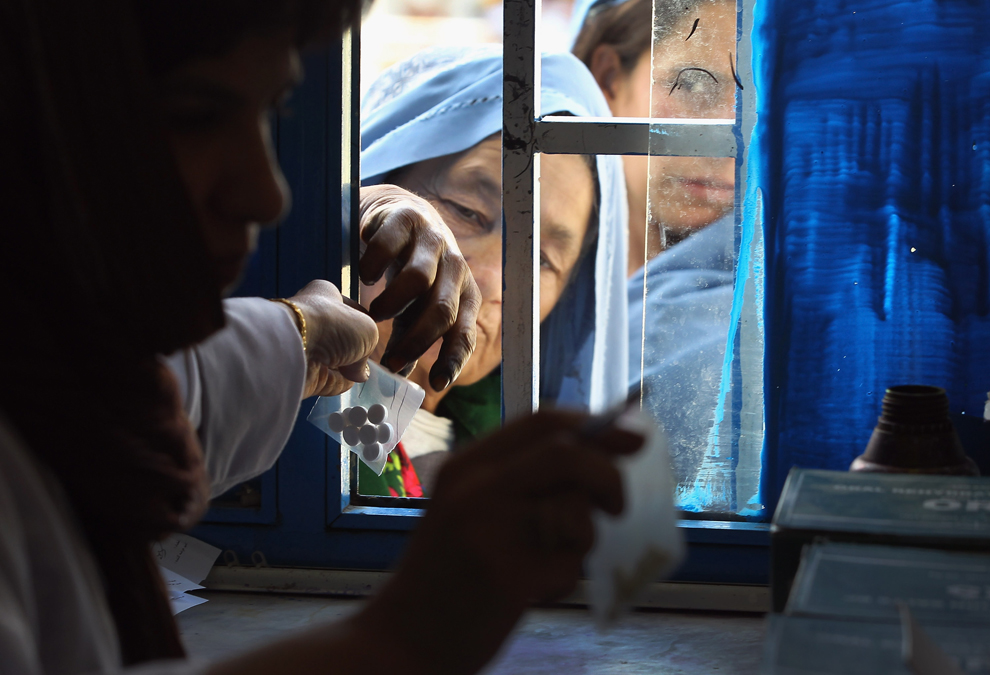
Afghan women receive prescription medicine after being treated at a USAID-funded clinic, September 7, 2011 in Farza, Afghanistan. Almost 10 years after the 9/11 attacks and the U.S. invasion of Afghanistan, the U.S. government funds some 500 Afghan health facilities nationwide, most run by non-governmental organizations contracted by the Afghan Ministry of Public Health. (John Moore/Getty Images)
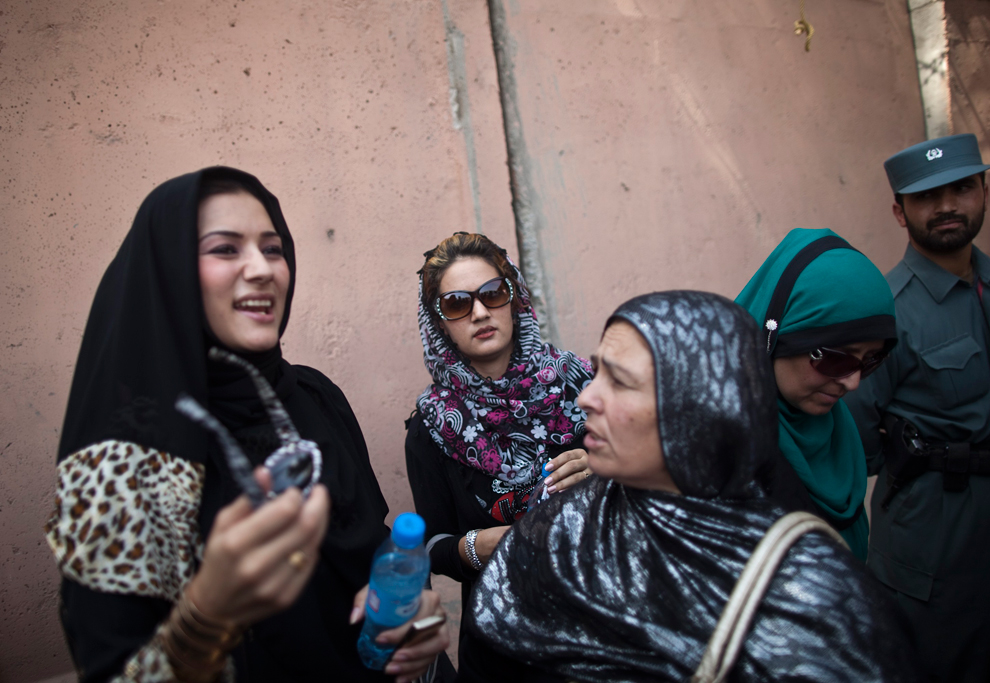
Female would-be Afghan lawmakers attend a protest in front of the Afghan Presidential palace in Kabul, September 7, 2011. Hundreds of supporters of would-be Afghan lawmakers, declared winners by a court but losers by an election body, blocked a main junction in downtown Kabul, the latest scene in a long-running political crisis. (Ahmad Masood/Reuters)

US Marine driver Lance Cpl. Ryan Ing, from Halewa, Hawaii, guides his armored vehicle as his convoy moves through Sangin, Helmand province, southern Afghanistan. (Brennan Linsley/Associated Press)
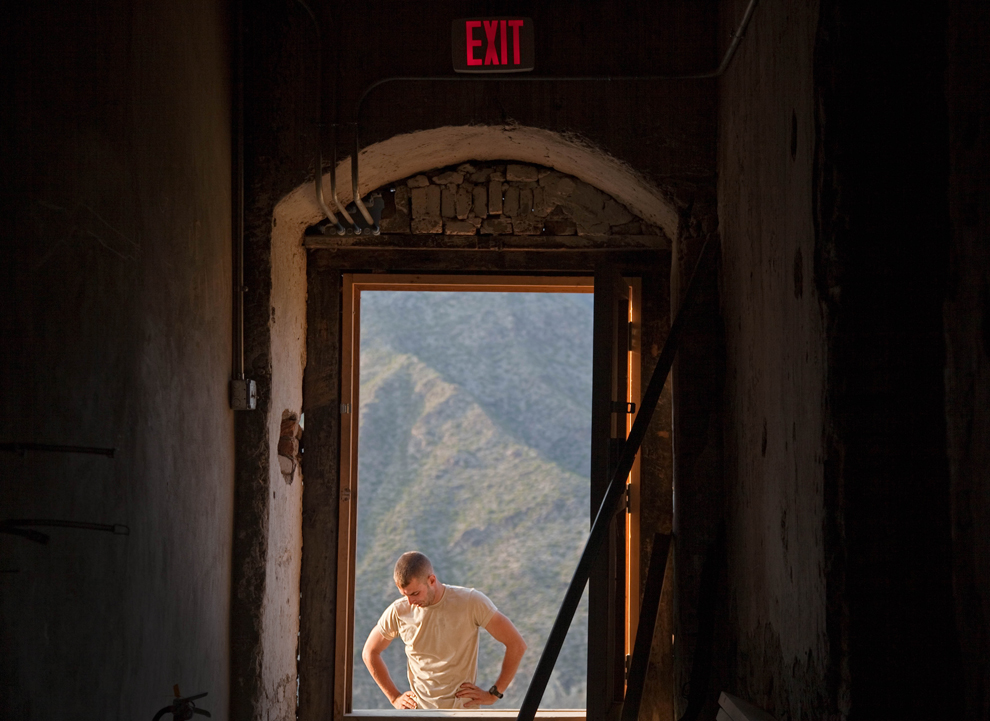
Spc. Steven Schwigert, 24, of Detroit, MI. stands outside the entrance to Observation Post Coleman in Kunar province, Afghanistan. (David Goldman/Associated Press)
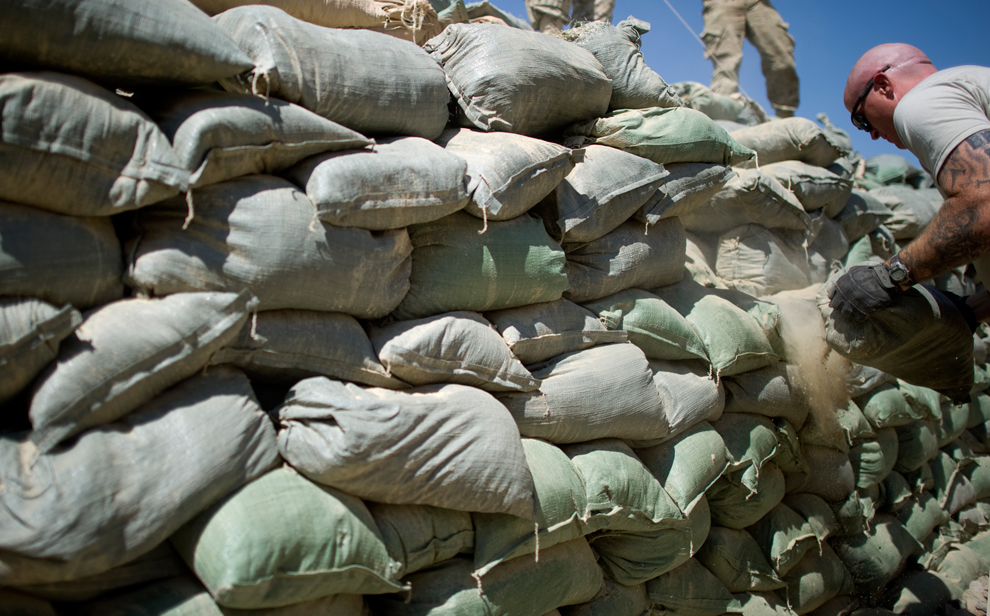
US army soldier Sergeant Andrew Warner places new sandbags on a bunker during reparation works in the FOB Kuschamond in the province of Paktika. (Johannes Eisele/AFP/Getty Images)
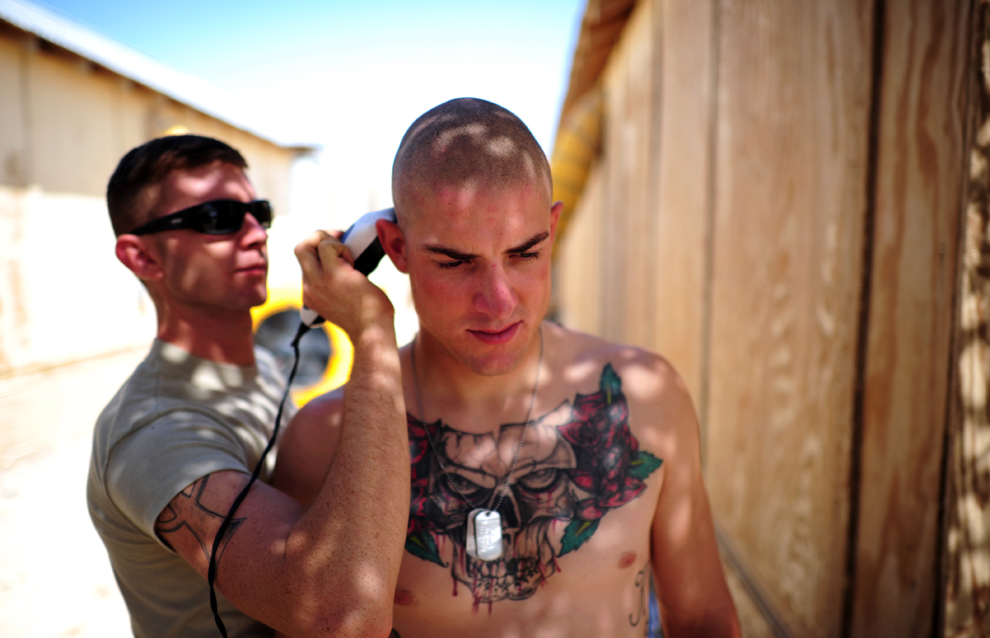
US army Pfc Kyler King gets his head shaved by Pfc Shawn Riggins in the FOB Kuschamond. Of 100,000 US troops in Afghanistan, 33,000 will leave by mid-2012. (Johannes Eisele/AFP/Getty Images)
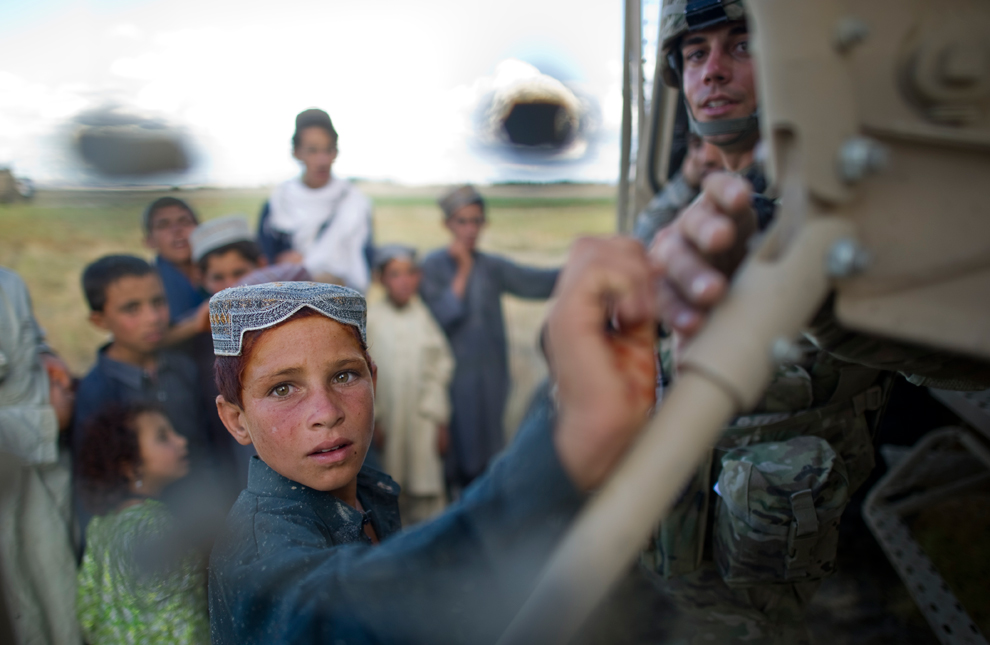
US 1st Lt Brandon Smith speaks with young boys during a mission in the village of Hasti in the province of Paktika. The first and second Platoon secured a convoy from Sharana to Kuschamond as part of their mission. (Johannes Eisele/AFP/Getty Images)

Pfc. Garrick Carlton, 21, of Sacramento, Calif., patrols up a mountain looking for an insurgent fighting position in Kunar province. (David Goldman/Associated Press)
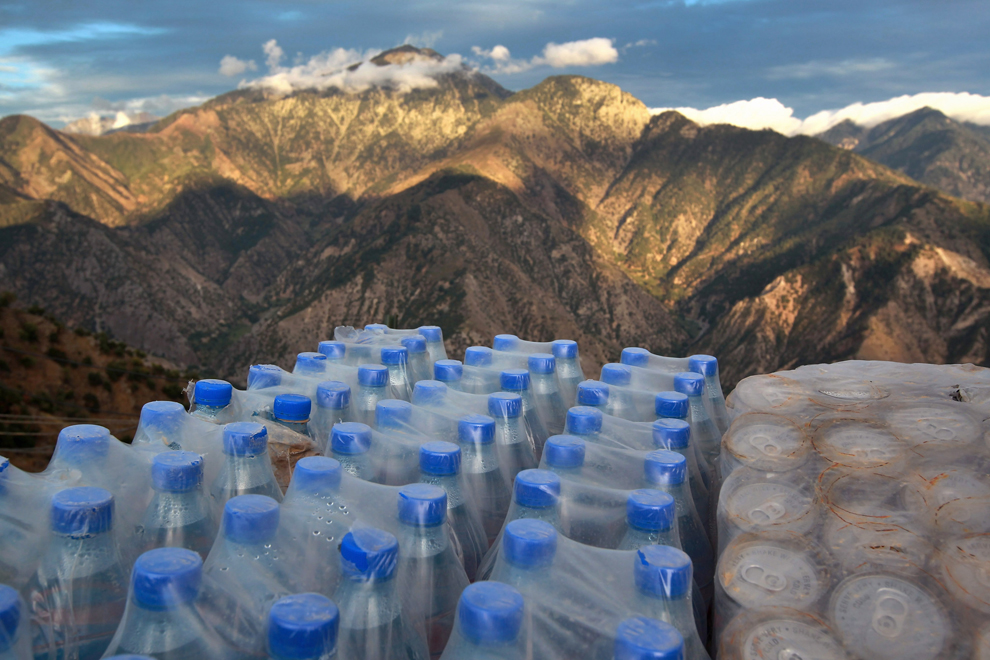
Supplies for US Army troops overlook the Hindu Kush mountains at Observation Post Mustang in Kunar Province, Afghanistan. The area, in northeastern Afghanistan near the Pakistan border, is a major infiltration route by Taliban fighters coming across from Pakistan and has seen some of the heaviest fighting of the war. (John Moore/Getty Images)

US Army soldiers from the 2-27th Infantry Regiment work out at Observation Post Mustang. (John Moore/Getty Images)
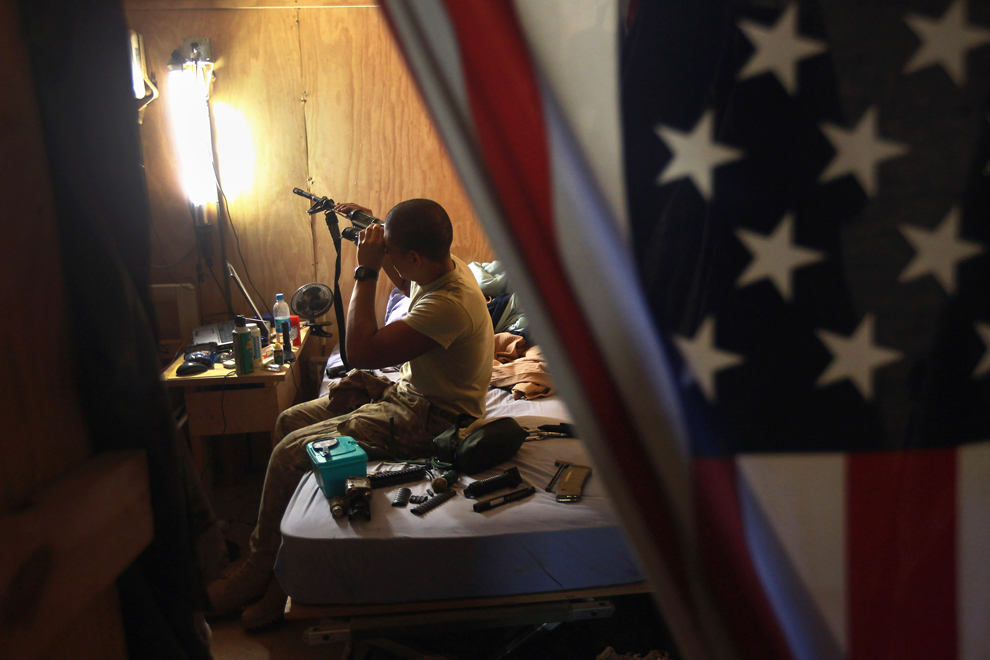
US Army Pfc. Natan Martinez from the 2-27th Infantry Regiment cleans his rifle in his quarters at Observation Post Mustang, Afghanistan. (John Moore/Getty Images)






















































No comments:
Post a Comment